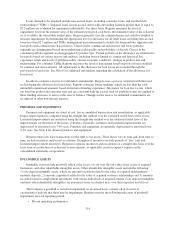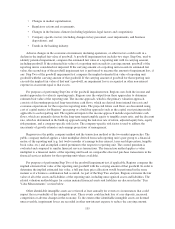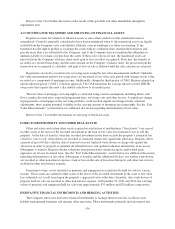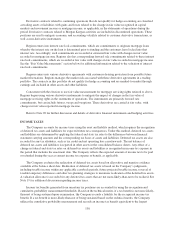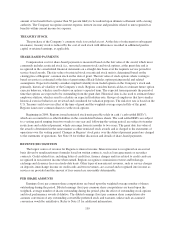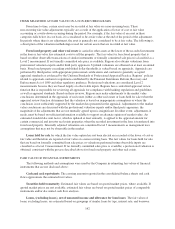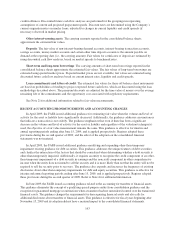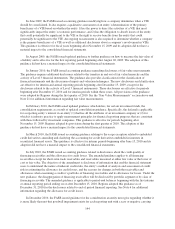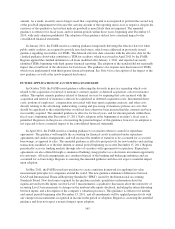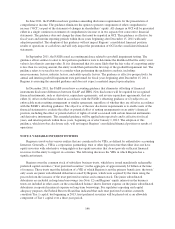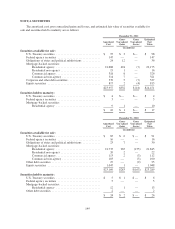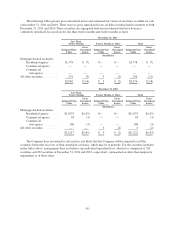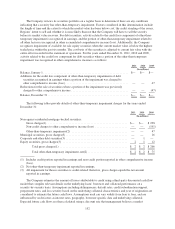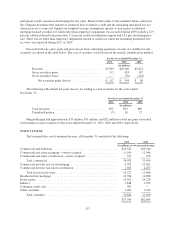Regions Bank 2011 Annual Report Download - page 168
Download and view the complete annual report
Please find page 168 of the 2011 Regions Bank annual report below. You can navigate through the pages in the report by either clicking on the pages listed below, or by using the keyword search tool below to find specific information within the annual report.In June 2009, the FASB issued accounting guidance modifying how a company determines when a VIE
should be consolidated. It also requires a qualitative assessment of an entity’s determination of the primary
beneficiary of a VIE based on whether the entity 1) has the power to direct the activities of a VIE that most
significantly impact the entity’s economic performance, and 2) has the obligation to absorb losses of the entity
that could potentially be significant to the VIE or the right to receive benefits from the entity that could
potentially be significant to the VIE. An ongoing reassessment is also required to determine whether a company
is the primary beneficiary of a VIE as well as additional disclosures about a company’s involvement in VIEs.
This guidance is effective for fiscal years beginning after November 15, 2009 and its adoption did not have a
material impact to the consolidated financial statements.
In August 2009, the FASB issued updated guidance to further guidance on how to measure the fair value of
a liability and is effective for the first reporting period beginning after August 26, 2009. The adoption of this
guidance did not have a material impact to the consolidated financial statements.
In January 2010, the FASB issued accounting guidance regarding disclosures of fair value measurements.
The guidance requires additional disclosures related to the transfers in and out of fair value hierarchy and the
activity of Level 3 financial instruments. The guidance also provides clarification for the classification of
financial instruments and the discussion of inputs and valuation techniques. The new disclosures and clarification
are effective for interim and annual reporting periods beginning after December 15, 2009, except for the
disclosures related to the activity of Level 3 financial instruments. Those disclosures are effective for periods
beginning after December 15, 2010 and for interim periods within those years. All provisions of the guidance
were adopted by Regions during the first quarter of 2010. See the “Fair Value Measurements” section above and
Note 21 for additional information regarding fair value measurements.
In February 2010, the FASB issued updated guidance which defers, for certain investment funds, the
consolidation requirements as a result of updated consolidation guidance. Specifically, the deferral is applicable
for a reporting entity’s interest in an entity (1) that has all the attributes of an investment company or (2) for
which it is industry practice to apply measurement principles for financial reporting purposes that are consistent
with those followed by investment companies. This guidance is effective for periods beginning after
November 15, 2009. Regions adopted its provisions during the first quarter of 2010. The adoption of this
guidance did not have a material impact to the consolidated financial statements.
In March 2010, the FASB issued accounting guidance relating to the scope exception related to embedded
credit derivatives amending and clarifying the accounting for credit derivatives embedded in interests in
securitized financial assets. This guidance is effective for interim periods beginning after June 15, 2010 and its
adoption did not have a material impact to the consolidated financial statements.
In July 2010, the FASB issued accounting guidance related to disclosures about the credit quality of
financing receivables and the allowance for credit losses. The amended guidance applies to all financing
receivables except for short-term trade receivables and receivables measured at either fair value or the lower of
cost or fair value. The objective of the amendment is disclosure of information that enables financial statement
users to understand the nature of inherent credit risks, the entity’s method of analysis and assessment of credit
risk in estimating the allowance for credit losses, and the reasons for changes in both the receivables and
allowances when examining a creditor’s portfolio of financing receivables and its allowance for losses. Under the
new guidance, the disaggregation of financing receivables will be disclosed by portfolio segment or by class of
financing receivable. The amended guidance is applicable to period-end balances beginning with the first interim
or annual reporting period ending on or after December 15, 2010. Regions adopted this guidance as of
December 31, 2010 for the disclosures related to end of period financial reporting. See Note 6 for additional
information regarding the allowance for credit losses.
In December 2010, the FASB issued guidance for the consideration an entity must give regarding whether it
is more likely than not that goodwill impairment exists for each reporting unit with a zero or negative carrying
144


